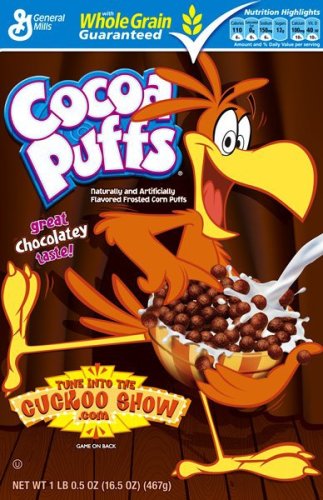In honor of Tabitha turning 11 this week, here’s a conversation from 6 years ago.
We have a little family tradition. When we go grocery shopping the weekend before your birthday, you can choose one box of any cereal you want-no restrictions. In the weeks and months leading up to the grand event, much time is spent in the cereal aisle weighing the advantages of the various sugar-laden options.
The week before turning five, Tabitha nearly dropped the ball. She just grabbed the first box of anything at hand. I don’t remember what it was, but it seemed out of character for her. I reminded her of the cereals she had been coveting as recently as the previous week.
She went for the generic Cocoa Puffs.
I steered her towards the real deal. If you’re only gonna eat ’em once a year, you might as well have the sugar-addled bird bouncing off the box in front of you, right?

One morning shortly afterwards, we had this conversation:
Tabitha: Do I have Cocoa Puffs or Cocoa Puff in my hand?
Me: Well, you have four Cocoa Puffs.
T: [with only one in her hand now] Do I have Cocoa Puffs or Cocoa Puff?
Me: You have Cocoa Puff.
T: [huge smile] Right!
Me: [with empty hand displayed] Do I have Cocoa Puffs or Cocoa Puff in my hand?
T: [silent but smirking]
Me: Well…Is it Cocoa Puff or Cocoa Puffs?
T: [continued silence]
Me: I have zero…
T: [bigger smile]
Me: …Cocoa…
T: Puffs!
Me: Yeah. Isn’t that weird? If you have one, it’s Puff; if you have none it’s Puffs.
T: I knew that.
Me: Of course you did.
T: No! I knew that; I was showing you that [you had zero] by not saying anything-zero words!
So what do we learn?
Children listen carefully to language patterns. They do not learn a native language like a second language in school. The rules are not carefully explained to them one at a time.
Instead they listen, speak, get corrected, and try again. All of this can be tremendously fun for child and parent alike.
It is an odd quirk of English that zero is plural, grammatically speaking. We talk about having one child, but zero children. More commonly, we use no instead of zero, as in My neighbors have no children. The grammar is the same either way; saying My neighbors have no child sounds funny to our ears.
Starting the conversation
In discussing place value, zero is sometimes called a place holder. To understand that, children need to understand zero as a number. They need to understand that zero can legitimately answer the question, How many are there?
We talk a lot about zero in our house. You can too. Ask your children, “Would you rather have one cookie, two cookies or zero cookies?” Ask who has more of something, even when one of the people has none.
The Mad Hatter in Alice in Wonderland gives an example of this. The March Hare offers Alice “some more tea”. When Alice says she can’t possibly have more, since she hasn’t had any yet, the March Hare replies, “It’s very easy to take more than nothing.”
Another silly language game we play in our house is this. If you look in the pantry and see that there are three cookies left, you can report this in the following two ways: (1) “I checked the cookies; there are three left,” and (2) “There are three cookies.” If, however, there are no cookies in the pantry, these two ways of reporting the sad fact become: (1) “I checked the cookies; there are none left,” and (2) “There are none cookies.” We like to treat none as a number. There is no good reason for this; it is for personal amusement purposes only.
Postscript
Tabitha again chose Cocoa Puffs on this, the week of her eleventh birthday. She is enjoying them, but she has also stated the obvious—they look like rabbit poop.
